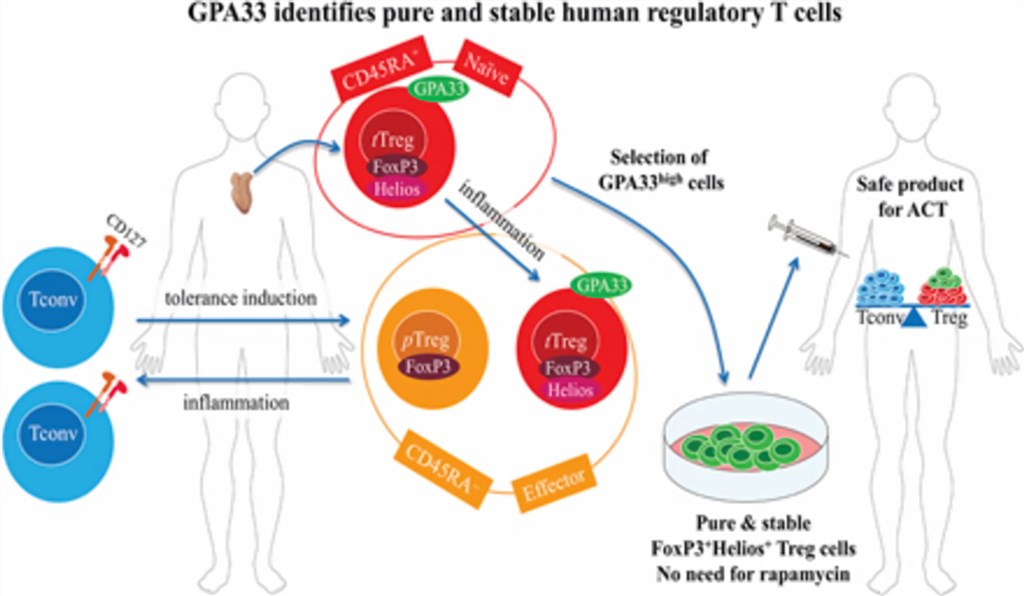GPA33 Assay Portfolio Service
Biology of GPA33
-
Structure. The glycoprotein A33 (GPA33) was first described as an immunoglobulin superfamily member of type I transmembrane proteins. The GPA33 antigen is an acylated 43-kDa glycoprotein containing 298 amino acids. GPA33 consists of two extracellular immunoglobulin domains containing 213 amino acids, a single transmembrane domain, and a short intracellular tail containing four acylation sites. GPA33 is both N-glycosylated and S-palmitoylated. S-palmitoylation post-translational modification is thought to have an important regulatory role for a wide variety of membrane and cytoplasmic proteins that participate in intracellular signaling.
-
Expression. GPA33 is expressed on the basolateral surfaces of the pyloric stomach, small intestine, colon and rectal epithelial cells. The GPA33 antigen is not secreted or shed into the bloodstream. An interesting feature of GPA33 antigen expression is its robust and uniform appearance in both the proliferating immature cells in the lower regions of crypts and the postmitotic, differentiating cells in the upper regions of crypts and throughout the small intestinal villi. GPA33 protein expresses in 95% of colorectal carcinoma (CRC), indicating it as a potential target for colon tumors therapy.
-
Function. The molecular function of GPA33 protein is unclear, but indirect evidence indicates a role in cell adhesion, trafficking, and the gut immune response. Variants at the GPA33 locus are associated with the rare autoimmune disorder (eosinophilic granulomatosis with polyangiitis).
CDX2 and GPA33
As a specific and sensitive immunomarker for CRC, caudal type homeobox 2 (CDX2) is one of the most commonly used stains in the investigation of Carcinoma of unknown primary (CUP). Nonetheless, its sensitivity has been recorded to range from 100% to 71%; poorly differentiated CRC, in particular, may lack CDX2 expression. The fact that CDX1 may regulate GPA33 expression and that physiological expression of A33 is almost limited to intestinal epithelium suggests that A33 might also serve as an immunomarker for CRC. Studies have shown great promise for A33 as both a sensitive and more specific marker of colorectal carcinoma than CDX2.
GPA33 and Regulatory T Cells (Treg)
Although the function of GPA33 is not known, it is found that GPA33 serves as a good marker to select pure populations of thymic Treg cells (tTreg cells). GPA33 is expressed on almost all thymic CD31+CD45RA+ Treg cells, the population that is about to egress into the periphery, as well as on most peripheral naive Treg (nTreg cells), which should, theoretically, predominantly consist of tTreg cells. Moreover, GPA33 is universally expressed on Treg cells in cord blood, which are presumably all thymic-derived. However, conventional T cells lose expression of GPA33 after TCR-mediated activation, and GPA33 does not appear on iTreg cells generated in vitro. GPA33 as a surface marker which, when used together with other Treg cell markers, allows isolation of pure and stable Treg cells, displaying the hallmarks of tTreg cells.
 Fig.1 GPA33 and human regulatory T cells. (Opstelten, 2020)
Fig.1 GPA33 and human regulatory T cells. (Opstelten, 2020)
What Can We Offer?
The functions of GPA33 are not completely understood, but this protein has been associated with immunological processes, proliferation and colonic mucosal repair in an animal model of colitis. Creative Biolabs provides a full set of GPA33 assay portfolio service, including but not limited to
-
Cytotoxicity assay
-
Cell apoptosis and necrosis assay
-
Biotinylation turnover assay (to measure endocytosis and recycling rates)
-
Cell-binding assays (to validate the specificity of antibody binding)
-
Northern blot analysis
-
Western blot analysis
-
Flow cytometry analysis
-
Immunohistochemistry and immunohistochemistry.
Creative Biolabs is the world’s leading service provider for tumor marker assay services (e.g., GPA33 assay portfolio service). We are proud to offer one-stop and step-to-step custom services to meet your customized demands. Your development program is led by expert scientists and regulatory teams who work with you to confidently select the best options to move forward. Please feel free to contact us.
Reference
-
Opstelten, R; et al. GPA33: A marker to identify stable human regulatory T Cells. J Immunol. 2020, 204(12): 3139-3148.
For Research Use Only | Not For Clinical Use


 Fig.1 GPA33 and human regulatory T cells. (Opstelten, 2020)
Fig.1 GPA33 and human regulatory T cells. (Opstelten, 2020)
 Download our brochure
Download our brochure